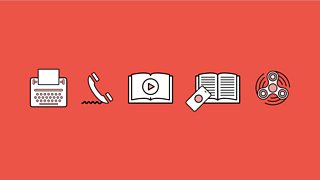
I design digital experiences at the ±«Óãtv. As part of this role, I joined the Accessibility Champions Network and became an advocate for accessible design in the things we make.
Since joining the network, I've become fascinated by the idea that when we design things to be accessible to all, the experience will actually be improved for everyone, not just those with impairments. This can drive innovation for businesses, and for whole industries.
The classic example of this is dropped curbs at road crossings. This solution was originally developed for wheelchair users, but it's also a huge benefit to anyone with a pushchair or wheeled luggage.
In an episode of the , August de los Reyes mentioned a few products that have a hidden history of accessible design. This inspired me to find out more.
I did some research and discovered five products that were invented to meet the needs of accessible users, but directly or indirectly became adopted by the mainstream. They got so popular that their original use has been forgotten.
Here's what I learnt.
Typewriter
In the 19th century, Pellegrino Turri developed a typing machine so that his blind friend, Countess Carolina Fantoni, could send personal letters without the need for her to dictate to a scribe.
Although the machine itself is lost, the Countess' letters still remain. Turri's machine used the same principle of pressing keys to print characters that the typewriter and computer keyboard still use to this day.
Telephone
In 1874, Alexander Graham Bell created a device called a phonautograph that allowed deaf students to see the vibrations of a sound etched onto smoked glass. The invention used an unusual component… the ear from a dead body.
It was this work that started Bell on the path to invent the telephone two years later.
Audiobooks
Talking books were one of the first applications of the phonographic when it was invented in 1877. As Thomas Edison said, they could "speak to blind people without effort on their part."
Talking books began to be used more widely in the 1930s when they were distributed to veterans wounded in the First World War.
It wasn't until the mid-1980s when audiobooks started to gain mainstream appeal. The introduction of the cassette made audiobooks much more portable, and the general public began to enjoy the convenience of listening rather than reading.
OCR scanners
In 1949, L.E. Flory and W.S. Pike of RCA Laboratories created a machine that scanned text using Optical Character Recognition (OCR) and read it aloud to blind people (you can find out more about that in ).
The invention never took off commercially, but it spurred on a whole new industry of OCR. The technology is now used for everything from libraries digitising their archives to the postal service scanning addresses.
Fidget spinners
Finally, the craze that swept the playgrounds across the planet in 2017. Although less of a secret, some may not know that fidget spinners were originally designed to calm people with anxiety and attention disorders, such as autism and ADHD.
They became a must-have gadget for young people across the world early last year, with a whole industry devoted to releasing fresh, creative designs and inventing new tricks.
I'm drawn to accessible design as it offers tough problems - the type that need really great thinking - to solve. These five examples show it's this kind of thinking that improves the lives of millions of people, and really stands the test of time.
Originally published 28/09/17 on






